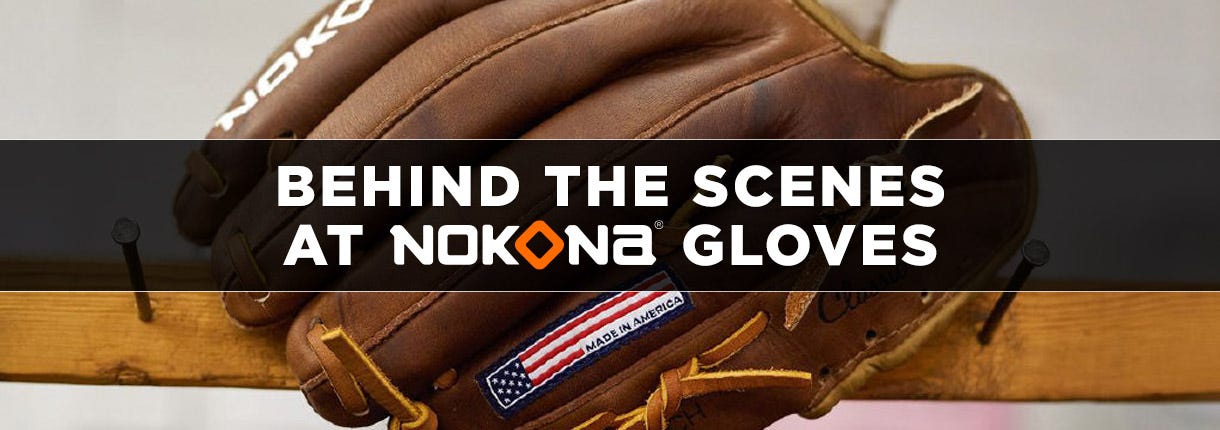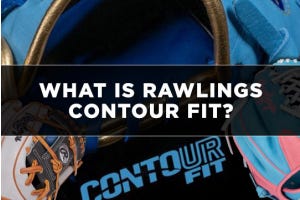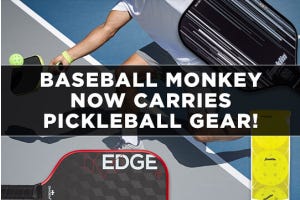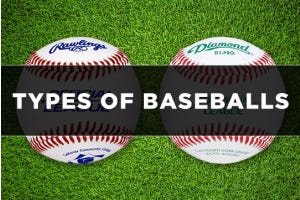Behind the Scenes at Nokona Gloves

Recently, BaseballMonkey had the privilege of heading to Nocona, Texas for a behind-the-scenes look at Nokona American Ballgloves. Keep reading to learn about our visit, see behind-the-scenes content, and learn what makes Nokona gloves special.
The story of the Nokona name has an interesting history. Before producing ball gloves, the company started as the Nocona Leather Goods Company in 1926 making purses and wallets. However, when the decision was made to switch to sporting equipment, the U.S. Trademark Office initially denied the application for the trademark of “Nocona” as a stand-alone word since that was already the name of the town. Instead, then President and Chairman Bob Storey opted for “Nokona” as a nod to Comanche Chief Pete Nocona who the town was named after. Interestingly, the Indians used a K in their spelling instead of the C. The name has stuck ever since!
Upon arrival, we were greeted by Rob Storey, Executive Vice President of Nokona. He is a direct descendent of the same Bob Storey who trademarked the Nokona brand name. He guided us to our first stop, the Nokona Museum.
Since 1934, all Nokona gloves have been handcrafted by American workers in their factory and they have a small museum showcasing many of the products they have made over the years. On display are vintage baseball equipment like gloves and bats, but also other products that Nokona has made over the years like footballs and football helmets. Nokona has even made military equipment like leather straps for binoculars. After learning more about the company’s history, we headed to the factory to get a look at the manufacturing processes behind the gloves.
The first step in making a baseball glove is picking out the leather. Nokona is known specifically for its quality of leather and unique leather options. Perhaps their most well-known leather is the “Walnut Crunch.” Rob explained how this is a full-grain steer hide that is left fully intact during the tanning process, which adds strength and causes the natural beauty and character of the leather to shine through to the surface. Extreme stress is applied to the carefully selected hides in the “crust” stage of tanning; oils and waxes are then injected to nourish, condition, and “hydrate” the leather. The hides are then bundled with high levels of pressure and colored with aniline dyes to provide the richest possible stain to create the legendary Nokona “crunch” look and feel.
In addition to this Walnut Steerhide, other colors of steerhide are also available along with American Kip, Japanese Calfskin, Bison, and Kangaroo. There are even exotic leathers like elephant, caiman, and alligator!
Once the leather has been selected, it gets scanned by a special machine that embeds a digital template onto the hide mapping out the different components of the glove. This machine helps to decrease leather waste along with ensuring that leather defeats are avoided. Interestingly, most hides can produce 10 gloves!
On the topic of hides, a unique component of Nokona’s manufacturing process is that all the parts of each glove come from the same hide if you choose a glove with all the same type of leather. The palm, back, and webs all come from the same hide to ensure even quality throughout the glove. A very cool attention to detail and craftsmanship!
Once the hide has been mapped, it then goes over to the cutting machines. These machines cut out the individual components of the glove with exact precision. Because the thickness of the hide can vary, the components are then taken to another machine which cuts the leather down to a specific thickness. Different components of the glove are cut to different thicknesses. For example, the palms will be a bit thicker to add to durability and performance.
Once the components are all cut to size, the pieces that require stamping or embroidery head off to get personalized. When it comes to customization, Nokona can do it all. They have a wide variety of palm stamps that you can choose from along with seemingly endless embroidery options. One of the signatures of Nokona gloves is the metal diamond which is hand hammered into the leather.
After the personalization has been done, the glove components head over to assembly. Nokona prides itself on being handmade, and this is where that is most notable. There is a team of sewers that work to sew up each glove. Rob explained that it takes each worker approximately 50 weeks to learn how to sew a baseball glove. The process is very labor intensive as all the different components need to be stitched along with the webs.
Interestingly, two gloves have been made so far. There is the inner glove, also called the inner lining, and the outside glove. These two components are glued and stitched together before the glove is “closed.” This is the most difficult part of the process as the inner and outer gloves are stitched together using one continuous thread.
Next, the glove is ready to be laced up. Just like with the sewing, this is done entirely by hand. Depending on the glove, there are around 120 holes on the glove that need to be laced in different ways depending on the style and web of the glove.
After the glove is laced, it heads over to a pneumatic machine that assists in breaking in the glove. This step is important as it softens the glove, shapes the leather, and takes out any wrinkles in the leather. After a quick break-in, the gloves are sprayed with a mixture of petroleum jelly and lanolin to give them a thin layer of oil to help moisturize and condition the leather. Once the gloves have dried and been inspected, the gloves are ready to be shipped out!
Nokona ball gloves are enjoyed all around the world, from little league parks to MLB stadiums, you will see Nokona gloves aiding in dazzling plays and helping to form life-long memories. There is an unmistakable sense of connection when you wear a Nokona. You feel connected to the people who made it, connected to people who have worn one in the past, and connected to others who choose a glove that holds the distinction of being “Made in the USA.”
If you are interested in getting a Nokona glove for yourself, you can view our wide variety of Nokona gloves here.








